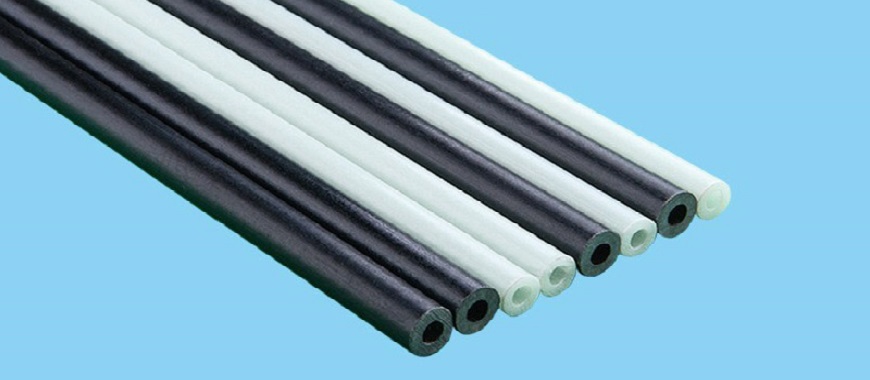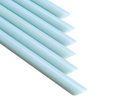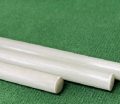
Marine fiberglass tube is a critical component in marine exhaust systems, offering both durability and performance. These tubes are primarily used in wet exhaust setups, where they help manage exhaust gases efficiently. Known for their resistance to high temperatures and corrosive environments, marine fiberglass tubes are widely preferred for ensuring safety and reliability in various marine applications. Similarly, products like the fiberglass scaffolding tube demonstrate the versatility of fiberglass materials, showcasing their ability to perform under demanding conditions. A fiberglass tube factory plays a vital role in producing these specialized marine tubes, ensuring that each product meets the high standards required for marine and construction environments. While marine fiberglass tubes excel in harsh saltwater and high-temperature environments, fiberglass scaffolding tubes highlight strength and stability in construction applications. Both underscore the importance of robust design and material selection in ensuring safety, reliability, and long-term performance across industries.
Manufacturing Process of Marine Fiberglass Tubes
Marine fiberglass tube manufacturing is a highly specialized process designed to maximize durability and safety in marine environments. Each stage in production is crucial to creating a tube capable of handling high temperatures, corrosion, and stress, making these tubes highly reliable in various marine applications.
Resin-Impregnated Fiberglass Construction
The construction of marine fiberglass tube involves layering fiberglass rovings with a resin coating. This process adds strength, resilience, and structural stability to each tube.
- Winding Process: Fiberglass rovings are wound onto a rotating mandrel, providing optimal hoop and longitudinal strength. This method ensures each tube can withstand intense pressure without cracking or deforming.
- Durability and Longevity: The precise manufacturing process helps enhance the tube’s resistance to both physical stress and long-term environmental wear, offering reliable performance in demanding marine conditions.
Fire and Corrosion Resistance Properties
A key advantage of marine fiberglass tube lies in its fire and corrosion resistance, achieved through the use of advanced resins and smooth linings.
- Fire Resistance Standards: Marine fiberglass tubes meet or exceed ASTM-D-365 standards, indicating a self-extinguishing capability that minimizes fire risks in engine compartments.
- High-Quality Resins: Specialized resins used in marine fiberglass tube manufacturing improve resistance to fire and chemicals. These resins ensure tubes remain safe under exposure to extreme temperatures.
- Smooth Interior Lining: The interior of each marine fiberglass tube is coated with a resin-rich liner that provides a smooth, friction-free flow. This not only optimizes the exhaust process but also shields the tube from corrosive substances, extending its lifespan.
Each component of the manufacturing process for marine fiberglass tube is crafted to meet rigorous marine demands, providing a dependable and long-lasting solution.
1.75 Fiberglass Mortar Tubes: Reliable Choice for Safe Displays
Marine Fiberglass Tube Hulls
Marine fiberglass tube hulls are increasingly popular in boat construction due to their strength, lightweight properties, and corrosion resistance. These tubes are used to reinforce and shape boat hulls, enhancing structural integrity and performance.
Benefits of Using Marine Fiberglass Tube Hulls
Marine fiberglass tube hulls offer numerous advantages for vessel builders and owners, improving both durability and functionality.
- Lightweight Construction: Fiberglass tube hulls are lighter than traditional metal hulls, reducing overall vessel weight and improving fuel efficiency.
- Corrosion Resistance: Marine environments can be harsh on materials. Fiberglass tube hulls resist rust and corrosion, ideal for saltwater exposure.
- Strength and Flexibility: Marine fiberglass tube hulls offer high strength-to-weight ratios and flexibility, absorbing impact without cracking or warping.
Factors Influencing the Use of Marine Fiberglass Tube Hulls
When choosing marine fiberglass tube hulls, several factors come into play, influencing the type and application of these hulls.
- Boat Size and Type: Smaller vessels benefit from lightweight hulls, while larger ships may require thicker tubes.
- Environmental Conditions: Tubes in high-salinity waters require reinforced resins for added corrosion resistance.
- Maintenance Requirements: Fiberglass tube hulls are easy to maintain, reducing upkeep costs over time.
Examples and Applications of Marine Fiberglass Tube Hulls
Marine fiberglass tube hulls are utilized in various vessels, each benefiting uniquely from this construction method.
- Recreational Boats: Lightweight and durable, fiberglass tube hulls are ideal for small leisure boats and personal watercraft.
- Commercial Fishing Vessels: The corrosion resistance of marine fiberglass tube hulls makes them suitable for saltwater fishing.
- High-Speed Boats: Fiberglass tube hulls reduce weight, making them excellent for speedboats and racing vessels.
Marine fiberglass tube hulls represent a modern solution for durable, efficient, and low-maintenance vessel construction, addressing the demands of both recreational and commercial boating sectors.
Marine Fiberglass Tube Installation
Proper installation of a marine fiberglass tube is essential to ensure optimal performance and safety. These tubes, designed to withstand high temperatures and corrosive marine environments, require specific placement and handling considerations to maximize their durability and effectiveness.
Installation Tips and Warnings
Effective installation of marine fiberglass tube in exhaust systems involves careful planning and adherence to key guidelines. Proper positioning and maintenance can extend the life and performance of the tube, while incorrect installation may lead to costly repairs or system failure.
- Placement and Positioning Recommendations: Marine fiberglass tubes should be positioned downstream of water-injection points in exhaust systems. This positioning helps manage temperature, ensuring the tube is exposed to controlled exhaust conditions.
- Temperature Limitations: To maintain long-lasting performance, marine fiberglass tubes should not be exposed to temperatures above 250°F. Prolonged exposure to excessive heat may degrade the tube material and reduce its effectiveness in managing exhaust flow.
- Avoiding Structural Load Transfer: Marine fiberglass tubes should be installed where they are isolated from structural loads of the boat. If loads from the vessel transfer onto the tube, stress points can form, leading to cracking or failure over time. Tubes installed with structural isolation help avoid damage to both the tube and surrounding components.
Additional Considerations for Marine Fiberglass Tube Installation
There are a few additional factors to consider during the installation process to further ensure that marine fiberglass tubes perform effectively in harsh marine settings.
- Vibration Management: In marine environments, engines and exhaust systems may cause vibrations that can impact tube integrity. Consider using vibration-damping mounts or clamps to protect the tube from excessive movement. Additionally, fiberglass tube end fittings should be securely fastened, as improper installation or loose fittings can lead to increased stress on the tube and fittings, potentially compromising their performance over time.
- Regular Inspection and Maintenance: Regular checks are important to catch any signs of wear, heat damage, or corrosion early. Routine inspection ensures that the marine fiberglass tube remains safe and functional throughout its lifespan.
- Examples of Installation Best Practices: For high-performance vessels, ensuring that the marine fiberglass tube has adequate ventilation can further reduce temperature build-up. In saltwater vessels, additional corrosion-resistant fittings may be used to enhance protection.
By following these installation guidelines, a marine fiberglass tube can provide reliable service and withstand the demanding conditions of marine exhaust systems. Proper handling and preventive measures contribute significantly to the durability and safety of the entire exhaust setup.
Reliable 3 Fiberglass Mortar Tubes for Pyrotechnic Needs
Marine Fiberglass Tube Availability and Pricing
The availability and pricing of marine fiberglass tube are important factors for anyone outfitting or maintaining marine exhaust systems. Knowing the standard options, replacement considerations, and key price factors helps in selecting the most suitable tube for specific marine needs.
Standard Length Options and Replacement Considerations
Marine fiberglass tubes come in a variety of lengths and sizes to meet diverse requirements in marine applications. These options allow for customization and easy replacement, ensuring efficient exhaust system performance.
- Available Lengths and Sizes: Marine fiberglass tube is typically sold in standard lengths of 1, 3, 5, and 10 feet. These varying lengths offer flexibility for different installation needs, from small personal watercraft to larger commercial vessels.
- Choosing the Right Size: When ordering or replacing a marine fiberglass tube, the correct length and diameter are crucial. Consider factors like exhaust flow, temperature exposure, and placement requirements. Selecting a tube with the proper wall thickness also ensures the tube withstands marine conditions effectively.
- Replacement Tips: Marine environments can wear down tubes over time, so routine checks are essential. If a tube shows signs of wear, such as cracking or discoloration, timely replacement can prevent system damage. Always select a replacement tube that matches the original specifications for optimal fit and performance.
Marine Fiberglass Tube Price Factors
Several factors influence the pricing of marine fiberglass tubes, making it essential to understand how material choices and dimensions impact costs.
- Length and Thickness: The longer and thicker the marine fiberglass tube, the higher the price. Thicker tubes provide greater durability, while longer tubes are suited for large vessels but increase material costs.
- Resin Type: Marine fiberglass tubes use different resins, each with unique properties. High-quality, fire-resistant resins are more expensive, but they provide added safety and chemical resistance, especially valuable in high-temperature applications.
Comparison of Marine Fiberglass Tube with Other Exhaust Tubing Materials
The table below outlines a comparison of marine fiberglass tube with other common exhaust tubing materials in terms of durability, weight, cost, and resistance:
| Material | Durability | Weight | Cost | Heat Resistance | Corrosion Resistance |
|---|---|---|---|---|---|
| Marine Fiberglass Tube | High | Lightweight | Moderate | High | High |
| Stainless Steel | Very High | Heavy | High | Very High | High |
| Aluminum | Moderate | Lightweight | Moderate | Low | Moderate |
| Rubber Exhaust Hose | Low | Moderate | Low | Low | Low |
Each material has unique strengths and weaknesses depending on vessel type and environmental conditions. Marine fiberglass tube offers a balanced combination of durability, heat resistance, and cost-effectiveness, making it a popular choice for marine exhaust applications.
Custom Fiberglass Water Slide Tubes for Pools
Key Considerations for Marine Fiberglass Tube
At GangLong Fiberglass, we’re dedicated to ensuring that each marine fiberglass tube meets the highest standards of durability and safety in marine environments. Proper installation is essential to maximize the tube’s lifespan and performance. Below are key factors to consider when installing a marine fiberglass tube, particularly for exhaust systems.
A successful marine fiberglass tube installation requires careful attention to placement, temperature, and load management. Following these guidelines helps maintain the tube’s integrity, keeping the exhaust system functioning efficiently over time.
- Placement and Positioning Recommendations: For optimal performance, the marine fiberglass tube should be positioned downstream from the water-injection point in an exhaust system. This placement minimizes exposure to high temperatures and reduces wear on the tube. Proper alignment within the exhaust path also ensures consistent flow and prevents unwanted backpressure, which can impact both the tube and the engine.
- Temperature Limitations: Marine fiberglass tubes are crafted to withstand high temperatures, but keeping them within safe operating limits is essential. To avoid thermal damage, the tube should not be exposed to temperatures exceeding 250°F. High temperatures can weaken the resin, reducing the tube’s longevity. At GangLong Fiberglass, we ensure our marine fiberglass tubes are tested to perform within recommended temperature ranges, providing peace of mind for safe, long-term use.
- Avoiding Structural Load Transfer: It’s crucial to install marine fiberglass tubes in areas free from structural loads from the vessel. When external loads transfer to the tube, stress points can develop, leading to cracks, warping, or even complete failure. We recommend isolating the tube from any boat structures to avoid this risk, ensuring that each component of the exhaust system remains protected from undue stress. If you need to remove a fiberglass tube, make sure to do so gently to avoid transferring any load that could cause damage to the tube or the vessel’s framework.
Additional Tips for GangLong Fiberglass Marine Fiberglass Tube Installation
At GangLong Fiberglass, we emphasize that each installation step contributes to the long-term reliability of the marine fiberglass tube. Below are some additional considerations:
- Vibration Control: The marine environment often involves constant vibrations, which can weaken or damage the tube if not managed. Using vibration-dampening mounts helps protect the marine fiberglass tube from excessive movement.
- Routine Inspections: Regular inspection of the marine fiberglass tube ensures early detection of wear or damage. Routine maintenance keeps the exhaust system performing well and extends the life of the tube, minimizing the need for replacements.
Each marine fiberglass tube from GangLong Fiberglass is crafted with precision and care, ensuring it stands up to the demands of marine use. Proper installation and regular maintenance are key steps in getting the most from our products.
FAQs about Marine Fiberglass Tube
Fiberglass tubes have versatile applications, particularly in marine environments due to their strength and resistance to corrosion. They are commonly used in marine exhaust systems to handle high-temperature gases. Fiberglass tubes are also favored for structural support in boats, such as reinforcing hulls and framing. The marine fiberglass tube’s lightweight design makes it ideal for watercraft, as it does not add significant weight to the vessel. Additionally, these tubes are corrosion-resistant, an essential property for withstanding saltwater exposure. Beyond marine uses, fiberglass tubes are applied in construction, electrical insulation, and aerospace settings, where strength and lightweight properties are critical. Their versatility and durability make them a preferred choice in many fields.
Cutting a fiberglass tube requires precision to avoid splintering and maintain a smooth edge. It is recommended to use a fine-toothed saw or a rotary tool with a cutting blade for clean results. Before cutting, secure the tube firmly to prevent movement. Mark the cutting line clearly and make steady, even passes to reduce fraying along the edges. To prevent dust inhalation and protect the eyes, always wear a dust mask and safety goggles during cutting. For larger marine fiberglass tubes, professional-grade equipment may be necessary to ensure an even cut without damaging the tube. Sanding the cut edge afterward can help smooth out any rough areas, creating a clean finish.
The compressive strength of a fiberglass tube typically ranges from 30,000 to 45,000 psi, depending on the tube’s thickness and resin type. This high compressive strength makes marine fiberglass tubes suitable for demanding applications, such as structural support and load-bearing elements in vessels. The strength also ensures that fiberglass tubes can withstand pressure from water and environmental forces without warping or breaking. Compressive strength is essential for tubes used in exhaust systems, where they endure continuous internal pressure. Marine fiberglass tubes are designed to maintain their integrity even under high-pressure conditions, contributing to safe and efficient operation in marine and industrial settings.

As the editor of GangLong Fiberglass, I have years of experience and in-depth research, focusing on cable tray products, fiberglass solutions, and grille systems. I incorporate years of industry insights and practical experience into every content, committed to promoting the progress of the industry. At GangLong Fiberglass, my commitment is reflected in every product, from innovative cable trays to durable fiberglass solutions and sturdy grille systems. As an authoritative voice in the industry, my goal is to provide valuable information to professionals and businesses and promote forward-looking solutions.


